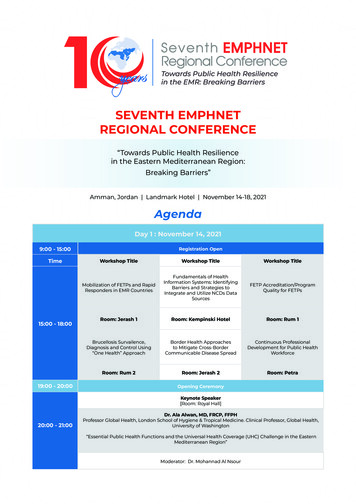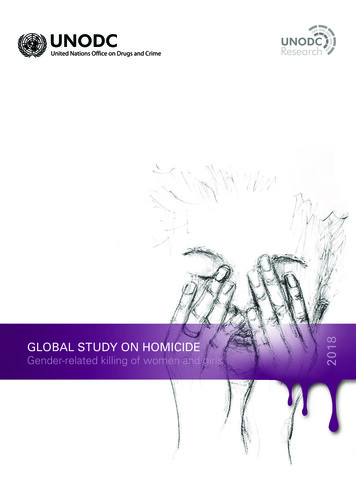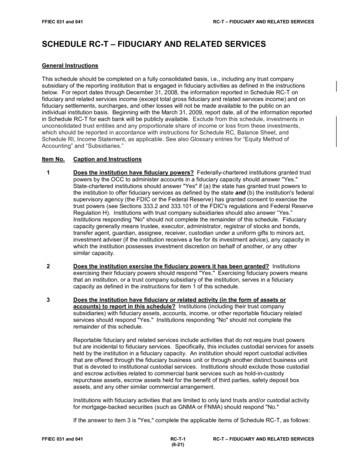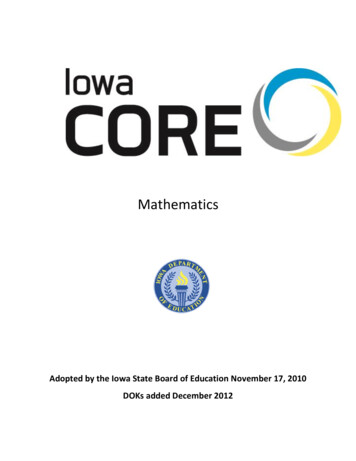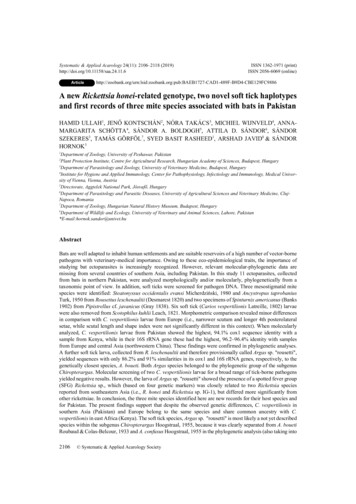
Transcription
Systematic & Applied Acarology 24(11): 2106–2118 SN 1362-1971 (print)ISSN 2056-6069 b:BAEB1727-CAD1-489F-B9D4-CBE129FC9886A new Rickettsia honei-related genotype, two novel soft tick haplotypesand first records of three mite species associated with bats in PakistanHAMID ULLAH1, JENŐ KONTSCHÁN2, NÓRA TAKÁCS3, MICHIEL WIJNVELD4, ANNAMARGARITA SCHÖTTA4, SÁNDOR A. BOLDOGH5, ATTILA D. SÁNDOR6, SÁNDORSZEKERES3, TAMÁS GÖRFÖL7, SYED BASIT RASHEED1, ARSHAD JAVID8 & SÁNDORHORNOK31Department of Zoology, University of Peshawar, PakistanPlant Protection Institute, Centre for Agricultural Research, Hungarian Academy of Sciences, Budapest, Hungary3Department of Parasitology and Zoology, University of Veterinary Medicine, Budapest, Hungary4Institute for Hygiene and Applied Immunology, Center for Pathophysiology, Infectiology and Immunology, Medical University of Vienna, Vienna, Austria5Directorate, Aggtelek National Park, Jósvafő, Hungary6Department of Parasitology and Parasitic Diseases, University of Agricultural Sciences and Veterinary Medicine, ClujNapoca, Romania7Department of Zoology, Hungarian Natural History Museum, Budapest, Hungary8Department of Wildlife and Ecology, University of Veterinary and Animal Sciences, Lahore, ts are well adapted to inhabit human settlements and are suitable reservoirs of a high number of vector-bornepathogens with veterinary-medical importance. Owing to these eco-epidemiological traits, the importance ofstudying bat ectoparasites is increasingly recognized. However, relevant molecular-phylogenetic data aremissing from several countries of southern Asia, including Pakistan. In this study 11 ectoparasites, collectedfrom bats in northern Pakistan, were analyzed morphologically and/or molecularly, phylogenetically from ataxonomic point of view. In addition, soft ticks were screened for pathogen DNA. Three mesostigmatid mitespecies were identified: Steatonyssus occidentalis evansi Micherdziński, 1980 and Ancystropus taprobaniusTurk, 1950 from Rousettus leschenaultii (Desmarest 1820) and two specimens of Spinturnix americanus (Banks1902) from Pipistrellus cf. javanicus (Gray 1838). Six soft tick (Carios vespertilionis Latreille, 1802) larvaewere also removed from Scotophilus kuhlii Leach, 1821. Morphometric comparison revealed minor differencesin comparison with C. vespertilionis larvae from Europe (i.e., narrower scutum and longer 4th posterolateralsetae, while scutal length and shape index were not significantly different in this context). When molecularlyanalyzed, C. vespertilionis larvae from Pakistan showed the highest, 94.1% cox1 sequence identity with asample from Kenya, while in their 16S rRNA gene these had the highest, 96.2–96.4% identity with samplesfrom Europe and central Asia (northwestern China). These findings were confirmed in phylogenetic analyses.A further soft tick larva, collected from R. leschenaultii and therefore provisionally called Argas sp. "rousetti",yielded sequences with only 86.2% and 91% similarities in its cox1 and 16S rRNA genes, respectively, to thegenetically closest species, A. boueti. Both Argas species belonged to the phylogenetic group of the subgenusChiropterargas. Molecular screening of two C. vespertilionis larvae for a broad range of tick-borne pathogensyielded negative results. However, the larva of Argas sp. "rousetti" showed the presence of a spotted fever group(SFG) Rickettsia sp., which (based on four genetic markers) was closely related to two Rickettsia speciesreported from southeastern Asia (i.e., R. honei and Rickettsia sp. IG-1), but differed more significantly fromother rickettsiae. In conclusion, the three mite species identified here are new records for their host species andfor Pakistan. The present findings support that despite the observed genetic differences, C. vespertilionis insouthern Asia (Pakistan) and Europe belong to the same species and share common ancestry with C.vespertilionis in east Africa (Kenya). The soft tick species, Argas sp. "rousetti" is most likely a not yet describedspecies within the subgenus Chiropterargas Hoogstraal, 1955, because it was clearly separated from A. bouetiRoubaud & Colas-Belcour, 1933 and A. confusus Hoogstraal, 1955 in the phylogenetic analysis (also taking into2106 Systematic & Applied Acarology Society
account that other known species of the subgenus are unlikely to occur in Pakistan). The novel Rickettsiagenotype from Argas sp. "rousetti", represents the first molecular identification of a Rickettsia sp.phylogenetically close to R. honei, and the first Rickettsia sp. from any bat-associated soft tick species insouthern Asia.Keywords: Chiroptera, Vespertilionidae, Pteropodidae, Argas, ChiropterargasIntroductionBats (Chiroptera Blumenbach 1779) are known for their widespread global occurrence, large numberof species, high population densities and frequent usage of urban habitats (in particular, presence incities, close to the human environment including buildings and stables: Dekker et al. 2013). Even ifconsidered alone, these ecological and taxonomic characters justify an "above the average"epidemiological significance for bats among mammals. Furthermore, bats have a special capacity toact as reservoirs of disease agents (Brook & Dobson 2015).In this context, bat ectoparasites represent a very important topic to study (Klimpel & Mehlhorn2014). Among them, the number of arachnid species (mites, ticks) tends to exceed that of insects inboth Europe (Frank et al. 2015) and the trans-Palaearctic boreal zone to the Far East (Orlova et al.2017). Blood-sucking arachnids (from Parasitiformes Leach, 1815) can play a role in transmittingvector-borne pathogens not only between bats themselves, but also through the ecological interfaceconnecting bats and domestic animals or humans. Thus, it was postulated that macronyssoid mitesmay transmit important viral and bacterial disease agents (causing encephalitis, hemorrhagic fever,rickettsioses and tularemia) from bats to humans (Balashov 2009; Fagre & Kading 2019). Soft ticksassociated with bats may attach to and suck blood from humans (Hoogstraal 1956a; 1985; Jaensonet al. 1994) or domestic animals (Manzano-Román et al. 2012). In particular, the Old World bat softtick, Carios (syn. Argas) vespertilionis Latreille, 1802 frequently infests domestic poultry in certainregions, as exemplified by Pakistan (Shah et al. 2006; Qamar et al. 2009). Such data support theveterinary-medical importance of bat ectoparasites, particularly of ticks and mites.Recently, the phylogenetic relationships of geographically diverse isolates of C. vespertilioniswere surveyed in the Old World, including samples from Europe, East Africa, central andsoutheastern Asia (Hornok et al. 2017a, 2017b). The presence of DNA from a great variety of vectorborne bacteria has also been demonstrated in these soft ticks (Hornok et al. 2019). Relevant sampleswere collected from three families of insectivorous bats (Rhinolophidae Gray, 1825;Vespertilionidae Gray, 1821; Miniopteridae Dobson, 1875). Taking into account that southern Asia,the genus Scotophilus (Leach 1821) and the family Pteropodidae Gray, 1821 (frugivorous Old Worldbats) were not represented in the above surveys, in this preliminary study ectoparasites werecollected from a lesser Asiatic yellow bat (Scotophilus kuhlii Leach, 1821), a fulvous fruit bat(Rousettus leschenaultii [Desmarest 1820]) and a Javan pipistrelle (Pipistrellus cf. javanicus [Gray1838]) in northern Pakistan. The species of mites were morphologically identified, whereas soft tickswere subjected to both morphometric and molecular-phylogenetic analyses.Materials and MethodsSample collection and morphological analysesMites and soft ticks were removed from three bats (S. kuhlii, R. leschenaultii, P. cf. javanicus)during bat monitoring in 2016, in northern Pakistan. All ectoparasites were stored in 96% ethanol.Data of sample collection are shown in Table 1.2019ULLAH ET AL.: A NEW RICKETTSIA HONEI-RELATED GENOTYPE2107
TABLE 1. Data of sample collection.Species andgenderLocalityDate of captureLatitudeScotophiluskuhlii Pakistan, Khyber Pakhtunkhawa,District Dir Lower Tehsil Munda,Camp Masjid Munda25/07/2016Pipistrellus cf.javanicus Rousettusleschenaultii LongitudeElevation TemperatureN 34 49.518 E 71 40.950 835 m36 CPakistan, Khyber PakhtunkhawaDistrict Bajaur Tehsil, Nawagi, Govt 07/10/2016Degree College NawagiN 34 41.896 E 71 20.345 1061 m28.5 CPakistan, Khyber PakhtunkhawaDistrict Swat Tehsil, Kabal, Kabal 10/10/2016gardenN 34 46.880 E 72 16.959 883 m21.3 CFour soft ticks (identified as C. vespertilionis larvae based on Petney et al. 2017) from S. kuhliiwere used for morphometric analysis, during which scutal length, scutal width and the length of 4thposterolateral setae were measured, because these parameters were previously found to be the mostdifferent between specimens of C. vespertilionis larvae from Europe and Vietnam (Hornok et al.2017a). For comparison, eight larvae of C. vespertilionis, collected in Hungary and in Romania in2018 (locality data not shown) were also included. Measurements were made with a VHX-5000digital microscope (Keyence Co., Osaka, Japan). Species and subgenus names of soft ticks are usedsensu Mans et al. (2019).Two mites collected from R. leschenaultii and two mites collected from P. cf. javanicus werecleared in lactic acid for morphological identification according to Rudnick (1960) (SpinturnicidaeOudemans, 1902) and Micherdzinski (1980) (Macronyssidae Oudemans, 1936).DNA extraction and molecular taxonomic analysesDNA was extracted from two further C. vespertilionis larvae, as well as from a soft tick larvacollected from R. leschenaultii (which was severely damaged, precluding morphologicalidentification). DNA was extracted from these larvae with the QIAamp DNA Mini Kit (Qiagen,Hilden, Germany) according to the manufacturer’s instructions, including an overnight digestion intissue lysis buffer and Proteinase-K at 56 C.The cytochrome c oxidase subunit I (cox1) gene was chosen as the primary target for molecularanalysis, on account of its suitability as a DNA-barcode sequence for tick species identification (Lvet al. 2014). The PCR amplifies an approx. 710 bp long fragment of the gene (Folmer et al. 1994),using the primers HCO2198 (5’-TAA ACT TCA GGG TGA CCA AAA AAT CA-3’) and LCO1490(5’-GGT CAA CAA ATC ATA AAG ATA TTG G-3’). Reaction components and conditions weremodified as follows: the reaction volume of 25 μl, contained 1 U (0.2 μl) HotStarTaq Plus DNApolymerase, 2.5 μl 10 CoralLoad Reaction buffer (including 15 mM MgCl2), 0.5 μl PCR nucleotideMix (0.2 mM each), 0.5 μl (1 μM final concentration) of each primer, 15.8 μl ddH2O and 5 μltemplate DNA. For amplification, an initial denaturation step at 95 C for 5 min was followed by 40cycles of denaturation at 94 C for 40 s, annealing at 48 C for 1 min and extension at 72 C for 1min. Final extension was performed at 72 C for 10 min. In addition, because no cox1 PCR productswere gained from C. vespertilionis larvae, a new internal primer pair was designed: forward (5’-TTTGGA GCA TGA TCT ATA ATA GTA-3’), reverse (5’-AAA ATA AAT GYT GGT ATA RRATTG G-3’).Another PCR was used to amplify an approx. 460 bp fragment of the 16S rRNA gene of IxodidaeKoch, 1844 (Black & Piesman 1994), with the primers 16S 1 (5’-CTG CTC AAT GAT TTT TTA2108SYSTEMATIC & APPLIED ACAROLOGYVOL. 24
AAT TGC TGT GG-3’) and 16S-1 (5’-CCG GTC TGA ACT CAG ATC AAG T-3’). Other reactioncomponents and cycling conditions were the same as above, except for annealing at 51 C.Molecular screening for vector-borne pathogensReverse line blot hybridization assay (RLB) was performed as previously published (Schötta etal. 2017), in order to screen soft tick DNA extracts for a broad range of vector-borne pathogens. Theoligonucleotides included group level (catch-all) probes and species-specific probes targeting eightspecies from Anaplasmataceae Philip, 1957, 17 species of piroplasms, eight species of borreliae andten Rickettsia species (Schötta et al. 2017).The citrate synthase (gltA) PCR product of the rickettsia-positive sample was sequenced. Thissample was further analyzed with three PCRs: (1) an approximately 480 bp long fragment of the 17kDa surface antigen gene of Rickettsia spp. was amplified with primers 17kd1 (5'-GCT CTT GCAACT TCT ATG TT-3') and 17kd2 (5'-CAT TGT TCG TCA GGT TGG CG-3') and (2) anapproximately 532 bp long fragment of the outer membrane protein A (ompA) gene of Rickettsiaspp. was amplified with primers Rr190.70p (5'-ATG GCG AAT ATT TCT CCA AAA-3') andRr190.602n (5'-AGT GCA GCA TTC GCT CCC CCT-3') as described previously (Hornok et al.2018). In addition, the rRNA intergenic spacer (ITS) region was amplified with the primers ITS-F(5'-GAT AGG TCG GGT GTG GAA G-3') and ITS-R (5'-TCG GGA TGG GAT CGT GTG-3')(Vitorino et al. 2003), modified as in the latter (ompA) PCR, except denaturation at 95 C for 20seconds and annealing at 52 C for 1 minutes.Purification and sequencing were done by Biomi Inc. (Gödöllő, Hungary). Obtained sequenceswere manually edited, then aligned and compared to reference GenBank sequences by nucleotideBLASTN program (https://blast.ncbi.nlm.nih.gov). Representative sequences were submitted toGenBank (accession numbers: MK571553-4 for the cox1, MK571555-6 for the 16S rRNA andMK571557-60 for the 17kDa, ompA, ITS and gltA sequences, respectively). The MEGA modelselection method was applied to choose the appropriate model for phylogenetic analyses. In thephylogenetic analyses reference sequences with high coverage (i.e. 99–100% of the region amplifiedhere) were retrieved from GenBank and trimmed to the same length. This dataset was resampled1,000 times to generate bootstrap values. Phylogenetic analyses were conducted with the MaximumLikelihood method, T3 and GTR models by using MEGA version 6.0.ResultsMorphological identification of bat-associated mite speciesThree mesostigmatid mite species were identified. Steatonyssus occidentalis evansiMicherdziński, 1980 (Macronyssidae) and Ancystropus taprobanius Turk, 1950 (Spinturnicidae)occurred on R. leschenaultii, whereas two specimens of Spinturnix americanus (Banks, 1902)(Spinturnicidae) were collected from Pipistrellus cf. javanicus.Morphological, molecular and phylogenetic analyses of bat-associated soft ticksCarios vespertilionis larvae (n 6) were only collected from S. kuhlii. Two parameters of four ofthese soft ticks from Pakistan, i.e. scutal length (range: 184–192 μm, mean: 188 μm) and shape index(scutum length to width ratio, range: 1.92–2.09, mean: 1.97) were not significantly different fromcorresponding data of soft ticks from Europe (scutal length range 188–229 μm, mean 205.3 m; ratiorange: 1.77–2.14, mean 1.93). However, C. vespertilionis larvae from Pakistan had significantly (P 0.0002) narrower scutum (range: 92–97 μm, mean: 95 μm) and significantly (P 0.007) longer 4thposterolateral setae (range: 65–79 μm, mean 71.7 μm) compared to European specimens (scutal width2019ULLAH ET AL.: A NEW RICKETTSIA HONEI-RELATED GENOTYPE2109
range: 103–110 μm, mean: 106 μm; length of 4th posterolateral setae in the range of 52–66 μm, mean:59.4 μm). The types of posterolateral setae were identical in the case of C. vespertilionis larvae fromEurope and Pakistan (i.e., serrate, separated surface protrusions in the upper half: Figure 1).FIGURE 2. Maximum Likelihood tree of soft tick cox1 sequences, shown according to the country of originbefore GenBank accession numbers. Sequences from this study are highlighted with red color. The scale-barindicates the number of substitutions per site.2110SYSTEMATIC & APPLIED ACAROLOGYVOL. 24
FIGURE 3. Maximum Likelihood tree of soft tick 16S rRNA sequences, shown according to the country oforigin before GenBank accession numbers. Sequences from this study are highlighted with red color. The scalebar indicates the number of substitutions per site.The two molecularly analyzed C. vespertilionis larvae yielded identical sequences. In theamplified part of the cox1 gene, these samples from Pakistan showed the highest, 94.1% (591/628bp) sequence identity with a sample from Kenya (GenBank: KX431956), and lower degrees of2019ULLAH ET AL.: A NEW RICKETTSIA HONEI-RELATED GENOTYPE2111
identities with samples from Europe (below 92%, i.e. 578/628 bp with KX431954) or southeasternAsia, Vietnam (below 92.2%, i.e. 579/628 bp with KX431958). On the other hand, in their 16S rRNAgene, C. vespertilionis larvae from Pakistan had the highest, 96.2–96.4% (424/440–441 bp) identitywith samples from Europe (e.g. KX831486) and central Asia (northwestern China) (KY657240), andlower degrees of identity with samples from Kenya (95%, i.e. 418/440 bp with KX831491) andsoutheastern Asia, Vietnam (below 94.6%, i.e. 417/441 bp with KX831495).Results of the above sequence comparisons were well-reflected by the topologies ofphylogenetic trees. Based on the cox1 gene, C. vespertilionis from Pakistan clustered together withC. vespertilionis from Kenya, and their separation from samples collected in central Asia(northwestern China) and Europe was highly (100%) supported (Figure 2). However, according tothe 16S rRNA gene, C. vespertilionis from Pakistan clustered together with samples from Europeand central Asia (northwestern China), with strong (99%) support of their separation from otherisolates (Figure 3).FIGURE 4. Maximum Likelihood tree of Rickettsia sequences, shown according to the country of origin beforeGenBank accession numbers. Sequences from this study are highlighted with red color. The scale-bar indicatesthe number of substitutions per site.2112SYSTEMATIC & APPLIED ACAROLOGYVOL. 24
The soft tick larva collected from R. leschenaultii and therefore provisionally called Argas sp."rousetti" yielded a cox1 sequence, which had the highest (but only 86.2%) identity (558/647 bp)with that of A. boueti Roubaud & Colas-Belcour, 1933 from South Africa (GenBank: KR907236).This was confirmed by the 16S rRNA gene analysis, showing the maximum (393/432 bp 91%)identity with A. boueti (KR907239). Phylogenetically, Argas sp. "rousetti" and A. boueti wereseparated with strong (97–99%) support (Figures 2–3) but belonged to the same group formed bymembers of the subgenus Chiropterargas Hoogstraal, 1955 (including A. confusus Hoogstraal,1955: Figure 3).Molecular and phylogenetic analysis of vector-borne bacteria in bat-associated soft ticksThe RLB results of two C. vespertilionis larvae were negative. However, the larva of Argas sp."rousetti" showed the presence of a spotted fever group (SFG) Rickettsia sp., which was not amongthose included in the species-specific probes of the test. The short gltA sequence of this rickettsiahad 100% (294/294 bp) sequence identity with several SFG species, including R. conorii (e.g.GenBank: EU716648) and R. honei (e.g. GenBank: AF018074), therefore analysis of additionalgenetic markers was inevitable. The 17 kDa antigen gene of Rickettsia sp. from Argas sp. "rousetti"showed the highest (383/384 bp 99.7%) sequence identity with that of R. honei (GenBank:AF060704). Its ompA gene was 98.3% (453/461 bp) identical to that of Rickettsia sp. IG-1(GenBank: EF219466), 98.1% (452/461 bp) identical to that of R. slovaca (GenBank: U43808) and97.8% (451/461 bp) identical to that of R. honei (GenBank: AF018075). The ITS sequence of thenew genotype showed 98.6% (350/355 bp) and 98% (348/355 bp) identity with R. mongolitimonae(GenBank: HQ710799) and R. slovaca (GenBank: AY125009), respectively. The ompAphylogenetic tree reflected the close relationship of Rickettsia sp. from Argas sp. "rousetti" with R.honei, and their separation was poorly supported (58%: Figure 4). These species/genotypes belongedto a sister group of the clade containing R. slovaca and R. conorii (Figure 4).DiscussionIn this preliminary study ectoparasites were collected from three bat species in Pakistan. To ourknowledge, all mesostigmatid mite species identified here are first records for their bat host speciesand for Pakistan. In the Palaearctic region, St. occidentalis occurs in the European-Caucasiansubregion (Orlova et al. 2017), therefore the present finding might represent its easternmost recordin Eurasia. Similarly, although spinturnicid mites were surveyed in the northern, boreal Palaearcticregion, neither Sp. americanus nor An. taprobanius are known to be present (Orlova & Orlov 2015;Orlova et al. 2017). Considering southern-southeastern Asia, Sp. americanus is known to occur inMalaysia (Ahamad et al. 2013), whereas An. taprobanius was reported to have a broad distribution,including Papua New Guinea, the Philippines, Laos, Malaysia, Thailand, India, Nepal and Sri Lanka(Corpuz-Raros & Lit 2015; Amarga et al. 2017). Therefore, first finding of Sp. americanus and An.taprobanius in Pakistan appears to be the westernmost record of these two species in Eurasia.The bat genus Scotophilus (including ten species) occurs in Sub-Saharan Africa, the Malagasysubregion and southern, southeastern Asia (Hutson et al. 2001). Scotophilus species are mentionedamong the preferred hosts of C. vespertilionis (Hoogstraal 1985), therefore finding of C.vespertilionis larvae on S. kuhlii in the present study is not entirely new. Here, based on cox1sequences, C. vespertilionis from Pakistan (representing southern Asia) was the most closely relatedto C. vespertilionis from Kenya (in east Africa), suggesting a more likely "paleogenetic connection"in this than in other directions. This may be partly explained with the co-evolution and co-dispersal2019ULLAH ET AL.: A NEW RICKETTSIA HONEI-RELATED GENOTYPE2113
of C. vespertilionis with its preferred hosts, vespertilionid bats, which (together with other lineagesof Yangochiroptera Koopman, 1984) most likely have an Asian-European origin dating back toapprox. 50 Mya (Teeling et al. 2005). The presence of vespertilionid bats in the southern part of theOld World may have resulted from multiple dispersal events, implying that their conspecificpopulations in Madagascar (and eastern Africa) and on the drifting Indian subcontinent (todaysouthern Asia) may have maintained the possibility of genetic exchange via vegetation rafts (actingas "stepping stones": Teeling et al. 2005) or islands across the broadening Indian ocean (Samonds etal. 2013). The common ancestry of C. vespertilionis in Europe and southern Asia (Pakistan) issupported by the present findings, because according to the 16 rRNA gene and/or setal morphologyC. vespertilionis larvae from Pakistan were similar to those from Europe and central Asia(northwestern China), but differed more significantly from those in Vietnam representing southeastAsia (as reported in Hornok et al. 2017b).Importantly, the level of cox1 sequence divergence between C. vespertilionis from Pakistan andEurope/Vietnam exceeded 7.8%, the estimated interspecific divergence between closely related hardtick species (6.1%: Lv et al. 2014). To exclude or to confirm the conspecificity of these soft ticklarvae, selected (scutal and setal) parameters were considered based on previous work (Hornok et al.2017a). Although scutal width and the length of 4th posterolateral setae were significantly differentbetween C. vespertilionis larvae from Europe and Pakistan, scutal length-to-width ratio and the typeof setae did not allow their distinction. The latter characters are regarded as more important toseparate soft tick species based on larval morphology (Jones & Clifford 1972; Venzal et al. 2013).In addition, the level of 16S rRNA sequence divergence was only 3.6–3.8% between C.vespertilionis from Pakistan and Europe, whereas in case of different species it is expected to beabove 5.4% (Lv et al. 2014). For example, when Ornithodoros (Carios) rondoniensis (Labruna,Terassini, Camargo, Brandão, Ribeiro &Estrada-Peña, 2008) was described as a new species, it had11% 16S rRNA sequence difference from the most closely related species (Labruna et al. 2008).Therefore, the present data suggest that C. vespertilionis in Pakistan and Europe belong to thesame species, despite of the observed minor morphological differences, which should rather beinterpreted as intraspecific variations between populations. Similarly, C. vespertilionis from Europeand Vietnam, which were genetically the most different (i.e., having up to 7.5% cox1 geneheterogeneity), were still regarded as conspecific (Hornok et al. 2017a). In addition, another speciesof the genus, C. pusillus Kohls, 1950 has larvae with distinct morphology (i.e. smaller size, equalpalpal articles) and different geographical distribution (Bangladesh, Korea, Philippines, Malaysia)from C. vespertilionis (Sonenshine et al. 1962; Hoogstraal et al. 1979), therefore this species can beexcluded from the explanations of the observed genetic differences.Pteropodidae (frugivorous Old World bats) have widespread distribution in Africa, southernAsia and Australia (Almeida et al. 2011). Among them, Rousettus species are not mentioned as thetypical hosts for members of the soft tick subgenus Chiropterargas, including Argas boueti(Hoogstraal 1985). On the other hand, A. boueti was reported from the frugivorous bat species R.aegyptiacus (Hoogstraal 1955). Argas boueti occurs in south, east and north Africa, Middle East,southern and southeastern Asia (Heisch 1951; Hoogstraal 1955; Hoogstraal 1985), but to the best ofour knowledge has not been reported from Pakistan. Here, a morphologically unidentifiable softticks larva collected from R. leschenaultii (provisionally called Argas sp. "rousetti") yielded a cox1sequence with the maximum, 86.2% similarity to that of A. boueti from South Africa, from which itclustered separately. Furthermore, Argas sp. "rousetti" and A. boueti belonged to the samephylogenetic group, represented by members of the subgenus Chiropterargas (including A.confusus). Other known species of Chiropterargas (for which sequences have not been available inGenBank for inclusion in the phylogenetic analysis here) are unlikely to occur in Pakistan, i.e. A.cordiformis (in Africa) and A. ceylonensis (only in Sri Lanka) (Hoogstraal et al. 1979). Although two2114SYSTEMATIC & APPLIED ACAROLOGYVOL. 24
(small and large size) "races" were described within A. boueti (Hoogstraal 1955), both were reportedfrom Africa. Therefore, the present results indicate the existence of a further, undescribed specieswithin Chiropterargas.Considering the novel Rickettsia genotype identified here in Argas sp. "rousetti", it was(phylo)genetically closest related to Rickettsia sp. IG-1 (reported previously from southeast and eastAsia, i.e. Taiwan and Japan: Tsai et al. 2008; Fujita et al. 2008). At the same time, Rickettsia sp. exArgas "rousetti" clustered together with a human pathogenic species, R. honei, known to occur insoutheast Asia (Thailand) and Australia (Stenos et al. 1998; Kollars et al. 2001). Reports onrickettsiae identified molecularly or serologically are rare in the region of Pakistan. Although apotentially new, unnamed rickettsia (JC880) was detected in this country (Robertson et al. 1970,1973), it was neither reported to be closely related to R. honei, nor was it associated with soft ticksor bats.To be classified as a new Rickettsia species, the sequences of a new genotype should notsimultaneously exceed 99.9% gltA or 98.8% ompA, and 99.2% 17 kDa identity with closely relatedspecies (Fournier et al. 2003, Bouyer et al. 2001), unlike shown here for Rickettsia sp. ex Argas"rousetti". In addition, the phylogenetic separation of the latter from Rickettsia sp. IG-1 (which isconsidered as a genetic variant of R. honei: Fujita et al. 2008) was poorly supported. Therefore,Rickettsia sp. ex Argas "rousetti" is considered as a new R. honei-related genotype, worth of furtherinvestigation. This is especially important in light of the fact that the closest relative of Argas sp."rousetti" (from which this rickettsia was identified here), i.e. A. boueti is known to occasionally feedon humans (Hoogstraal 1956b). Taken together, this is the first molecular identification of aRickettsia sp. phylogenetically close to R. honei, and from any bat-associated soft tick species insouthern Asia.AcknowledgementsMolecular work was supported by NKFIH 130216 and the 17896-4/2018/FEKUTSTRAT grant ofthe Hungarian Ministry of Human Capacities. ADS was supported by the János Bolyai ResearchScholarship of the Hungarian Academy of Science. The authors are grateful to Atta Ullah(Departmentof Human Genetic, Hazara University, Mansera, Khyber Pakhtunkhwa, Pakistan),Jehan Zeb (Department of Zoology, Abdul Wali Khan University, Mardan Khyber Pakhtunkhwa,Pakistan), Abid Ullah (Department of Zoology, University of Peshawar, Khyber Pakhtunkhwa,Pakistan) and Khurshaid Anwar (Department of Livestock and Dairy development, VeterinaryResearch and Diseases Investigation Center, Balogram Swat, Khyber Pakhtunkhwa, Pakistan) fortheir help. All laboratory work was performed using the logistics of the Department of Parasitologyand Zoology (University of Veterinary Medicine) and of the Plant Protection Institute (Centre forAgricultural Research, Hungarian Academy of Sciences) in Hungary, and of the Institute forHygiene and Applied Immunology (Center for Pathophysiology, Infectiology and Immunology,Medical University of Vienna) in Austria.ReferencesAhamad, M., Ibrahim, H., Bujang, M.K., Sah, S.A., Mohamad, N., Nor, S.M., Ahmad, A.H. & Ho, T.M.(2013) A survey of acarine ectoparasites of bats (Chiroptera) in Malaysia. Journal of Medical Entomology, 50, 140–146.https://doi.org/10.1603/ME11240Almeida, F.C., Giannini, N.P., DeSalle, R. & Simmons, N.B. (2011) Evolutionary relationships of the old2019ULLAH ET AL.: A NEW RICKETTSIA HONEI-RELATED GENOTYPE2115
world fruit bats (Chiroptera, Pteropodidae):
2018 (locality data not shown) were also included. Measurements were made with a VHX-5000 digital microscope (Keyence Co., Osaka, Japan). Species and subgenus names of soft ticks are used sensu Mans et al. (2019). Two mites collected from R. leschenaultii and two mites collected from P. cf. javanicus were

